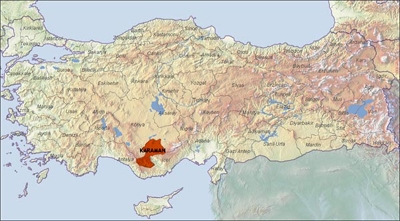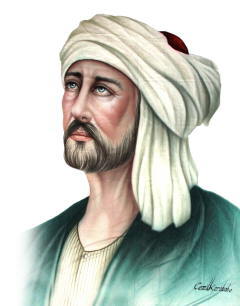








Karaman town (2011 pop. 138,135) is located in South central Turkey, at the northern foot of the Taurus Mountains (see map). The town owes its name to Karaman Bey who was one of the rulers of the Karamanids. The former name comes from the Greek Laranda which in turn comes from the Luwian language Larawanda, literally "sandy, a sandy place". The ancient Larende was renamed "Karaman" after the chieftain of a Turkic tribe conquered the city c.1256 and set up the independent Muslim state of Karamania, which at one time comprised most of Asia Minor. A successor state of the Seljuk empire, Karamania existed until its final subjugation by the Ottoman Turks in the late 15th century. Karaman has retained ruins of the Karamanid castle.
Its former Christian status is reflected by the fact that there was a Roman Catholic titular see for the city. Yunus Emre (c. 1238-1320), the poet resided in Karaman and is believed to be buried beside the Yunus Emre Mosque. A small adjacent park is adorned with quotations from his verse, many of them unfortunately graffiti-splattered. In 1222, the Sufi preacher Bahaeddin Veled arrived in town with his family, and the Karamanoğlu emir built a medrese to accommodate them. Veled's son was the famous Mevlana Jelaluddin Rumi, who married his wife, Gevher Hatun, while his family was living in Karaman. It was here, too, that his mother died in 1224. Today she is buried, along with other family members, in the Aktekke Mosque (also known as the Mader-i Mevlana Cami), which Alaeddin Ali Bey had built to replace the original medrese in 1370.
 The Region of 1001 Churches, the Karaman region, 150 kilometers from Konya is an undiscovered, mystical land of gently rolling hills and valleys, towering mountains, many monasteries, churches and chapel-complexes. It is a paradise for photographers, walkers, nature-lovers and explorers. The Hittites settled in this region and many remains, including inscriptions have been discovered. One of the highest mountains in this region, Mt. Karadag (2,288 meters) is locally called Mahalac; its ancient name is Angel Michael. On top of the mountain, Hittites constructed a temple; an altar where inscriptions remain. There are also the 4th century remains of a monastery, church and a chapel complex; the name of this complex was the Angel Michael Complex. There is a beautiful view here. Visitors can still see the remains of churches and chapels at Madensehir, 45 km from Karaman, on the northern slope of Mt. Karadag. Derbe, 30 km north of Karaman, was an important early Christian settlement; St. Paul came here to preach. Near Taskale, 48 km east of Karaman, on the rocky northern slope of Yesildere Valley, are the remains of the fascinating historical city of Manazan. Built during Byzantine times, the entire city of narrow lanes, houses, squares, storage facilities, chapels and cemeteries (occupying an area approximately three kilometers long and five stories high) was carved into the rocky hillside of the valley. Today, parts of the city are still used for wheat storage.
South of Karaman up a steep narrow road are the remains of a beautiful Byzantine monastery Alahan. Much still stands, and there is some fine stone carving to admire. This magnificent location offers a breathtaking view..
Going from Ankara towards Konya and on to Karaman, one has to pass through a vast and silent plain. Over the changing seasons, this boundless landscape, stretching on into the distance, is clothed in the brown of the earth, emerald green, harvest yellow and snow white. It plays with your senses, alternatively as a mysterious and dignified plain, and then as the disquieting distance of an endless plateau. Time has many faces, and is reach' at every moment to present you with an open door. Inside you a voice asks, "Where am I going?" You're going to Karaman; to crack open the "Gates of Time." As you go through this landscape, which the Hittites called "The riat Country," it's not at all obvious that you are passing over the first trade routes, the lands of the lirst empires. All of the signs seem to have withdrawn to the margins, and closed the gates of time that lead to them. But the observant traveler can still hear the lively voices of the caravans, the hubhub of the Silk Route merchants, the cries of warring tribes and the poetic songs of the simply dressed itinerant dervishes. Though the signs are vague, everything around you hints that you're unraveling a rich skein of knowledge. The borders of Kazimkarabekir prefecture announce that you are nearing the main town of Karaman. The Hacibaba Mountains are another landmark. Reigning over the Toros range, the Hacibaba Mountains are a majestic sight rising out of this boundless expanse. If they could speak, it's as if they would say, "Traveler! If it's Karaman you want to know, it's not enough to get used to the plains and go romping over the plateaus. You also have to get to know the mountains too, and the history hidden within them!" Those who try to reach Karaman by passing from the shores of the Mediterranean and over the Toros range see the flatness of the plains give way to the grandeur of the mountains. One behind the next, the mountain ridges extend into the distance. Along the way you come across surprises like cedar forests, natural features like the Goksu and Ermenek rivers, graves from long-extinguished civilizations, and caves. Wherever you look, you see a sign of life, or a portal of time opening to the fiiturp and the past.
The storm died down, and Kerem continued on. As he left it in the distance, he looked back, and what did he see?
In light of its surroundings, Karaman is a center that provides the opportunity to pass through a variety of gates and take a trip through time. A day trip can take you to see multiple layers of nature, history and culture. If you want, you can go from the loneliness of the steppes to the jagged peaks of the Toros Mountains, the Goksu River valleys to high cedar forests, see herds of wild horses and mountain sheep, all in one day. Or, you can head out to archaeological sites such as Pinarbasi, Catalhoyuk and Canhasan, and within the same day, learn about the Hittite gods and kings at Eflatunpinar, Ivriz or Kizildag. Another day you can see the works left by those on the path of St. Paul at Binbirkilise and Alahan. Strolling around the city, you have the rare opportunity to see the footsteps of Mevlana's first footsteps, take in the climate that created Yunus Emre, and become acquainted with Turkish/Islamic historical works. To understand a monument like the Karaman Fortress, which can be considered a work both of the Kararaans and the Ottomans, will add to your understanding of our past. The Nefise Hatun Medrese reminds us of the stubborn and dignified stance an Karaman girl forced into die role of art Ottoman mother... A little further along, at the Karaman Organized Industrial Area, you will witness the new stones being laid alongside these cultural treasures. Starting with agriculture, these efforts at industrialization are carrying Karaman forward into the present, lending it strength and diversity. It's impossible to know who will come to Karaman, and with what dreams. But we can be sure that they will leave as different people. In their minds, their luggate and their memories will be a new Karaman. because they will not only have experienced the mountains and plains, the past and present, rumor and truth, industry and agriculture, nomads and settled people; they will have acquired their own knowledge of Karaman's 10 thousand year history. Because Karaman opens the "Gates of Time" to all who wish to enter.
|







 Karaman:
Karaman: Karadag Mountain seems to be standing guard to help one understand Karaman better, and peak the visitor's curiosity. It knew those first people who settled 4,500 years ago, where Karaman Fortress rises today. It knew those pioneers who succeeded in planting and harvesting in Karaman, who became experts in mining here. It has seen wars, just and unjust; occupations and migrations. It knows kings, khans, wise men and folk minstrels. It watches tirelessly over Karaman like a dignified witness waiting at the gates of time.
Karadag is an extinct volcano; now peaceful, its fires have long since gone out, it has poured out its rage and gone silent. Perhaps this is why it's a pitch-black mountain, or perhaps because it didn't tell Asik Kerem where Asli was... The folk legend has it that Asik Kerem went searching for his beloved Ash. As the nights got shorter and the days longer, his journey took him to Karaman. But fate was again a cheat; a wind came up and turned into a violent storm. Losing his way, Kerem took his lute in hand and struck its strings; instead of fate, he called out to the mountain:
Karadag Mountain seems to be standing guard to help one understand Karaman better, and peak the visitor's curiosity. It knew those first people who settled 4,500 years ago, where Karaman Fortress rises today. It knew those pioneers who succeeded in planting and harvesting in Karaman, who became experts in mining here. It has seen wars, just and unjust; occupations and migrations. It knows kings, khans, wise men and folk minstrels. It watches tirelessly over Karaman like a dignified witness waiting at the gates of time.
Karadag is an extinct volcano; now peaceful, its fires have long since gone out, it has poured out its rage and gone silent. Perhaps this is why it's a pitch-black mountain, or perhaps because it didn't tell Asik Kerem where Asli was... The folk legend has it that Asik Kerem went searching for his beloved Ash. As the nights got shorter and the days longer, his journey took him to Karaman. But fate was again a cheat; a wind came up and turned into a violent storm. Losing his way, Kerem took his lute in hand and struck its strings; instead of fate, he called out to the mountain: The best place to seek out the remains of this long history is the Karaman Museum. The Karaman of today, with its wide boulevards, businesses, parks, memorials, apartments and industrial complexes, is a city that has opened its doors to modern times. The historical and cultural treasures share the same streets and avenues with these new realities, work, technology and a faster paced life.
The best place to seek out the remains of this long history is the Karaman Museum. The Karaman of today, with its wide boulevards, businesses, parks, memorials, apartments and industrial complexes, is a city that has opened its doors to modern times. The historical and cultural treasures share the same streets and avenues with these new realities, work, technology and a faster paced life.
